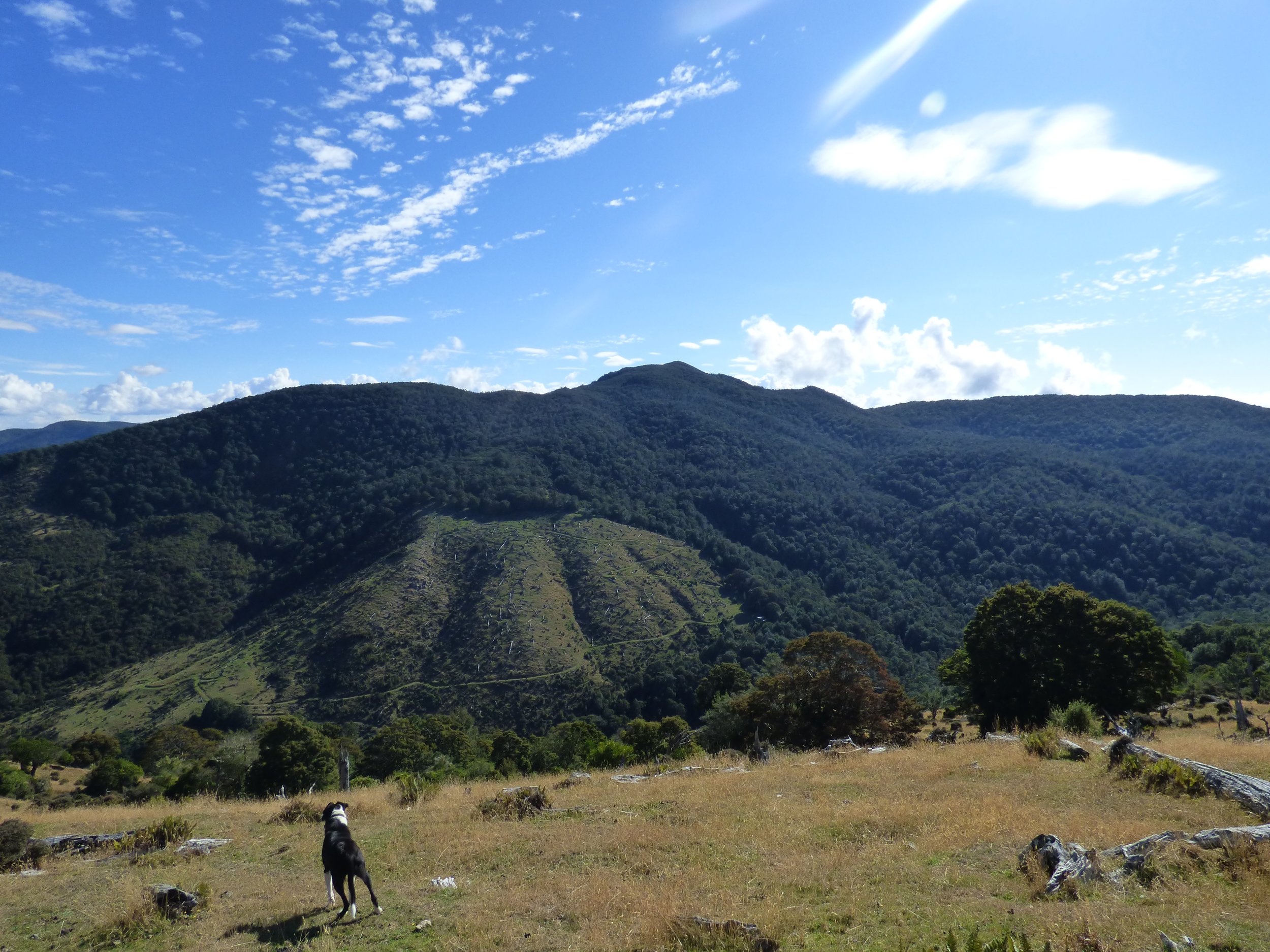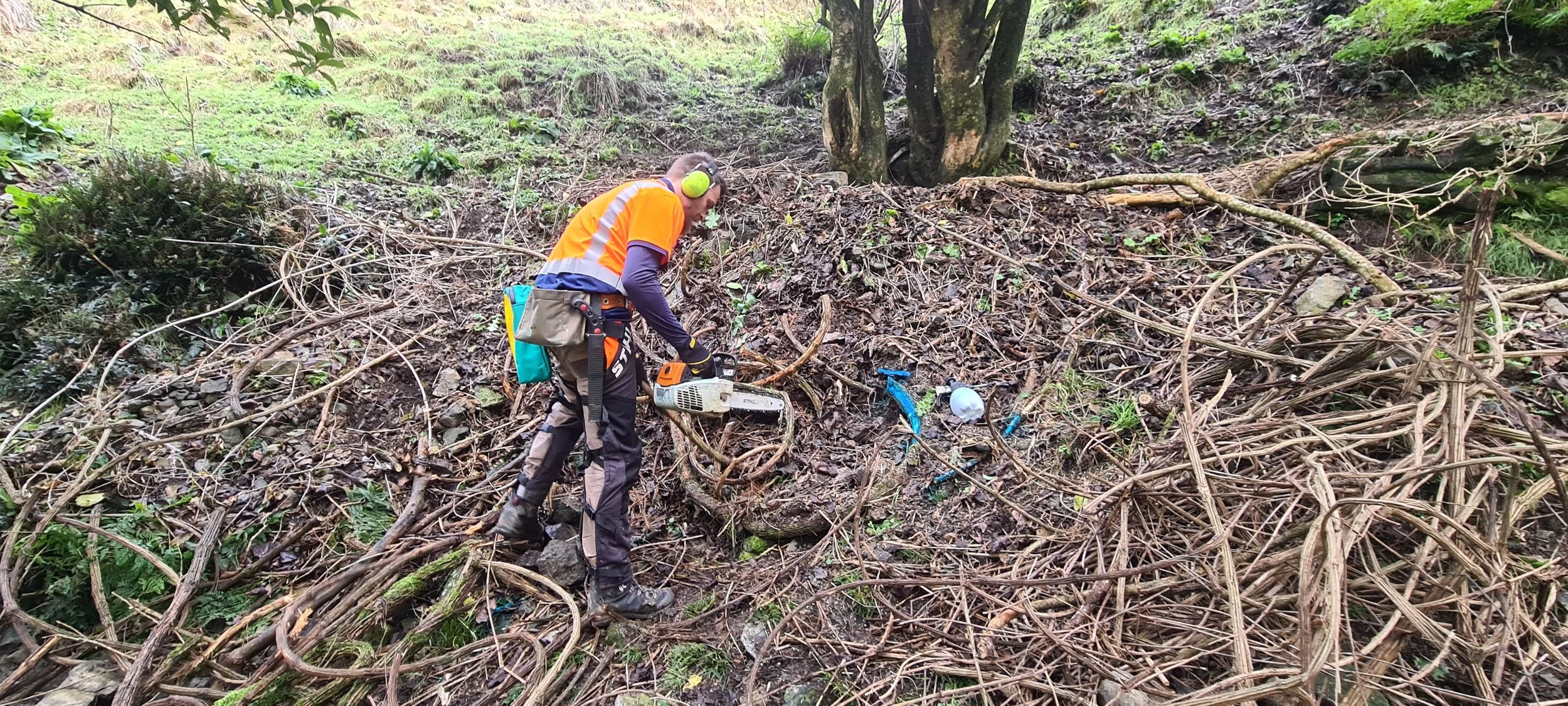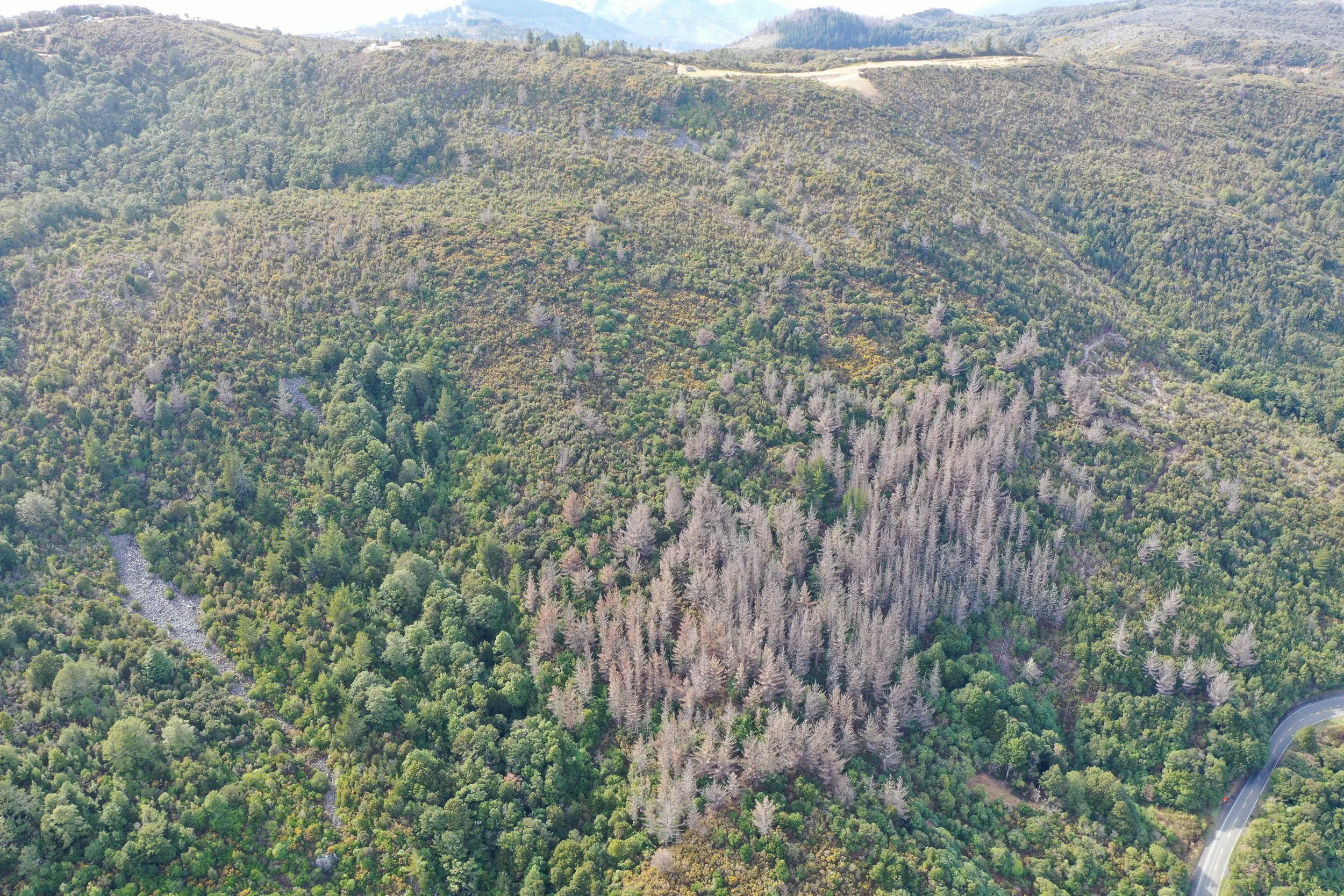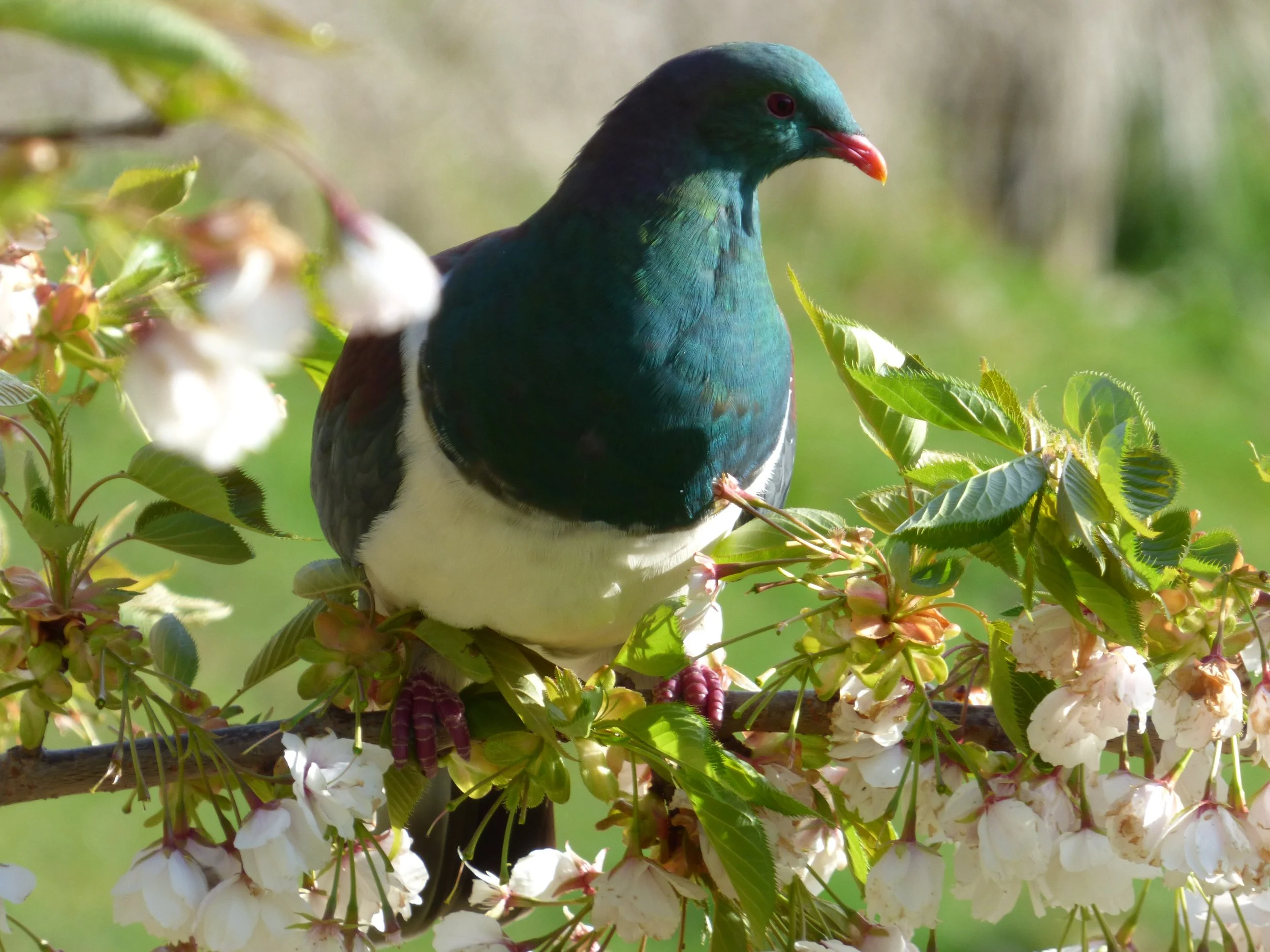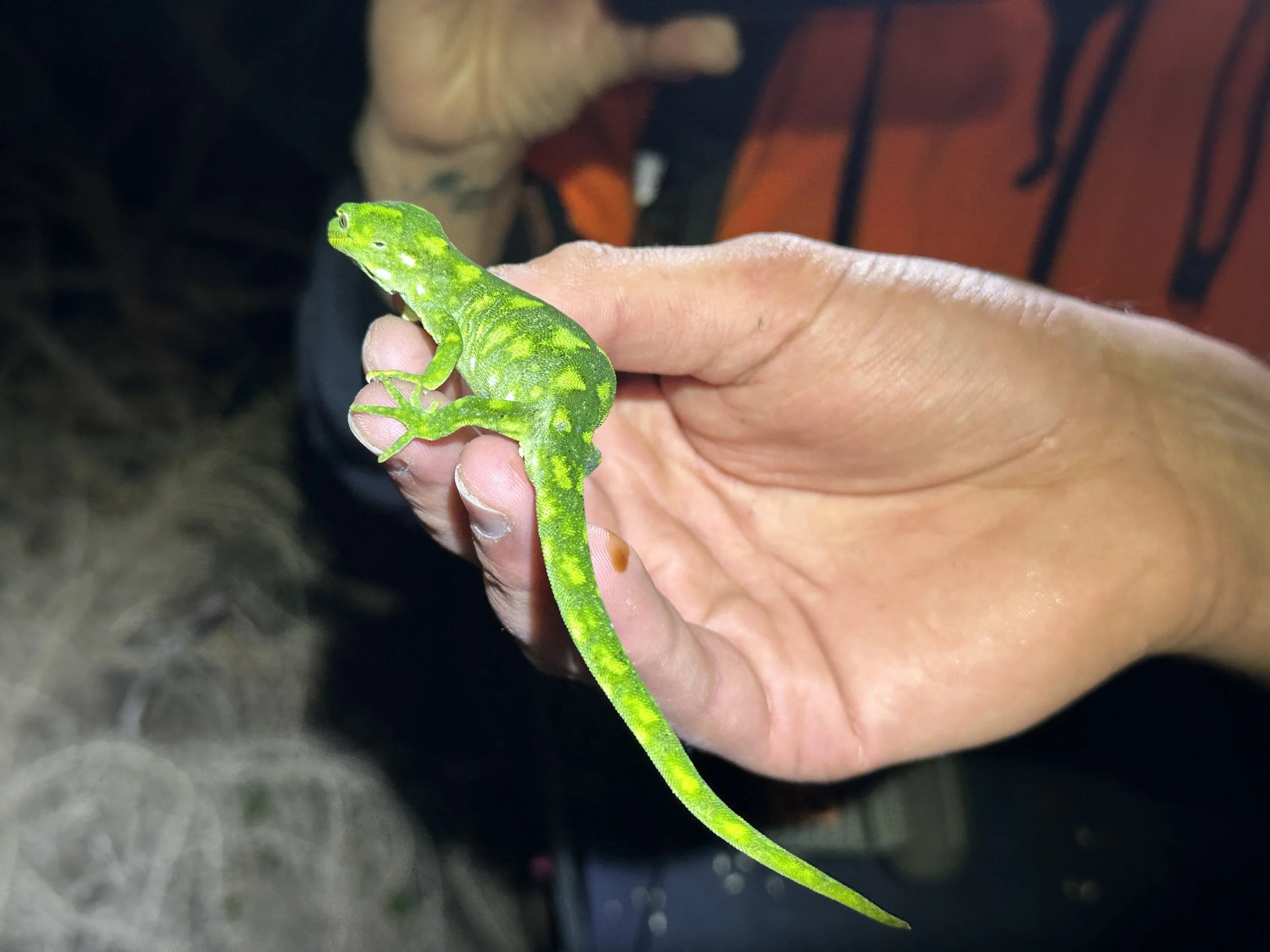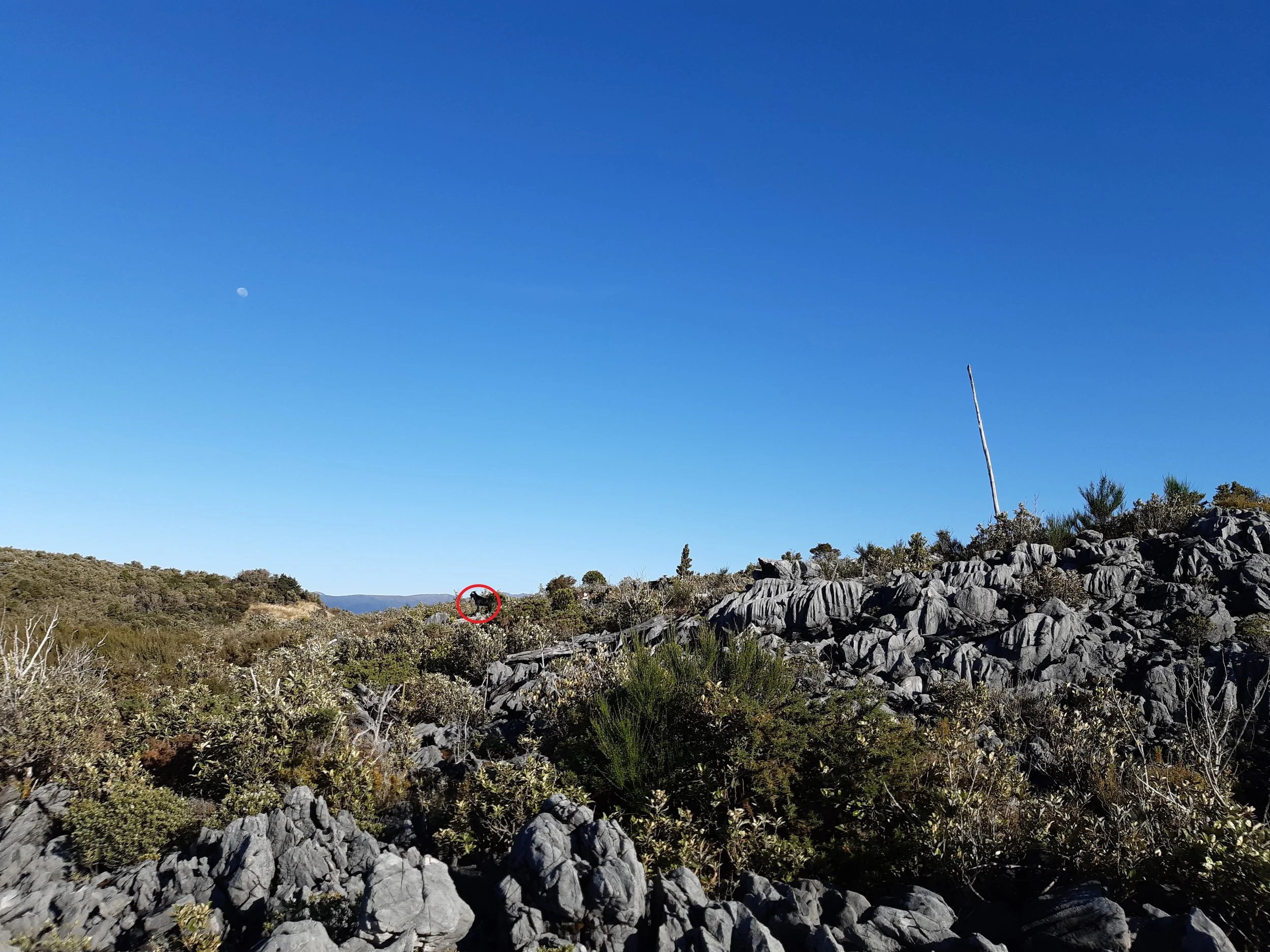PROJECT PIKIKIRUNGA
Photo by Amanda Henderson - Abel Tasman National Park from Kairuru
Pikikirunga: 'Climb Up High' encompasses the Trust's name and vision for its whole ecosystem approach to restoration and protection projects on Takaka Hill's private and neighbouring Abel Tasman and Kahurangi National Parks. The Pikikirunga Range dominates the Tākaka Hill and Golden and Tasman Bays landscape. Author of Rocks and Hard Places - The Tākaka Hill, Cliff Turley, describes Tākaka Hill, also known as The Marble Mountain, as "The chaotic landscape of marble protrusions, sinkholes, tomo and caves is the outstanding geological feature of the Tākaka Hill, a source of fascination to all who pass over it." The Pikikirunga Range was uplifted along the Pikikirunga fault line to form the steep western scarp rising above the Tākaka Valley with a gentler dip to the Riwaka Valley. Tākaka Hill's unique geology and location have seen the evolution of equally unique indigenous species that the Trust is working hard to restore and protect.
PROJECT PIKIKIRUNGA
Pikikirunga: 'Climb Up High' encompasses the Trust's name and vision for its whole ecosystem approach to restoration and protection projects on Takaka Hill's private and neighbouring Abel Tasman and Kahurangi National Parks. The Pikikirunga Range dominates the Takaka Hill and Golden and Tasman Bays landscape.
Author of Rocks and Hard Places - The Takaka Hill, Cliff Turley, describes Takaka Hill, also known as The Marble Mountain, as "The chaotic landscape of marble protrusions, sinkholes, tomo and caves is the outstanding geological feature of the Takaka Hill, a source of fascination to all who pass over it."
The Pikikirunga Range was uplifted along the Pikikirunga fault line to form the steep western scarp rising above the Takaka Valley with a gentler dip to the Riwaka Valley. Takaka Hill's unique geology and location have seen the evolution of equally unique indigenous species that the Trust is working hard to restore and protect.
OUR WHOLE ECOSYSTEM APPROACH
A whole ecosystem approach acknowledges the value of biodiversity beyond individual species. Ecosystems consist of a diverse array of species, each playing a unique role in maintaining the overall balance and functioning of the ecosystem. By protecting and restoring entire ecosystems, we help conserve biodiversity and promote the long-term sustainability of native species.
OUR WHOLE ECOSYSTEM APPROACH
A whole ecosystem approach acknowledges the value of biodiversity beyond individual species. Ecosystems consist of a diverse array of species, each playing a unique role in maintaining the overall balance and functioning of the ecosystem. By protecting and restoring entire ecosystems, we help conserve biodiversity and promote the long-term sustainability of native species.
National Park Halo Predator Control Project
This project aims to protect native plants and animals from Abel Tasman National Park and Kahurangi National Park by controlling rats, stoats, and possums on private land on Tākaka Hill, which lies between the two parks. By reducing predators, we can help improve the natural balance of the environment and support the growth of vulnerable species like the whio duck. This will benefit the ecosystem and allow other species like kaka and pateke to expand their habitats onto private land.
National Park Halo Predator Control Project
This project aims to protect native plants and animals from Abel Tasman National Park and Kahurangi National Park by controlling rats, stoats, and possums on private land on Takaka Hill, which lies between the two parks. By reducing predators, we can help improve the natural balance of the environment and support the growth of vulnerable species like the whio duck. This will benefit the ecosystem and allow other species like kaka and pateke to expand their habitats onto private land.
Tākaka Hill Pest Plant Control
In 2019, a thorough study was done to identify and manage pest plants on private land on Tākaka Hill with the help of funding from the DOC Community Conservation Fund. The study identified 48 pest plants on Tākaka Hill, and more may be found during control efforts. Some pest plants are considered high priority for eradication because they are known to be harmful, are not widespread, or are isolated. The goal is to manage these pest plants effectively through a detailed plan.
Takaka Hill Pest Plant Control
In 2019, a thorough study was done to identify and manage pest plants on private land on Takaka Hill with the help of funding from the DOC Community Conservation Fund. The study identified 48 pest plants on Takaka Hill, and more may be found during control efforts. Some pest plants are considered high priority for eradication because they are known to be harmful, are not widespread, or are isolated. The goal is to manage these pest plants effectively through a detailed plan.
Hawkes Lookout Restoration and Protection Project
The Trust collaborates with DOC Motueka to champion restoration efforts at Hawkes Lookout. Offering various volunteer opportunities, the Trust organizes working bees for planting, clearing around new vegetation, managing pest plants, and conducting predator control. In a notable achievement in 2022, the Trust and DOC Motueka came together to install a macrocarpa seat for public enjoyment along the path to the Hawkes Lookout viewing platform.
Hawkes Lookout Restoration and Protection Project
The Trust collaborates with DOC Motueka to champion restoration efforts at Hawkes Lookout. Offering various volunteer opportunities, the Trust organizes working bees for planting, clearing around new vegetation, managing pest plants, and conducting predator control. In a notable achievement in 2022, the Trust and DOC Motueka came together to install a macrocarpa seat for public enjoyment along the path to the Hawkes Lookout viewing platform.
Takaka Hill Community Recycling Depot
The Trust's approach to the whole ecosystem is exemplified by its involvement in establishing the Tākaka Hill Community recycling depot in 2020. Previously, residents travelled over 30km to dispose of their recycling at the Motueka Resource Recovery Centre. However, through a successful application to the 2020 Tasman District Council (TDC) Community Environmental Grant, the Trust facilitated the creation of a local recycling depot, reducing the distance residents need to travel to just a few kilometres. Ravensdown Ngarua Lime Works generously contributed the land, carried out earthworks, and provided construction materials for the depot. By collaborating with Waka Kotahi NZTA and Smart Environmental Ltd, the Trust ensured that the depot met all safety requirements for the convenient and secure drop-off of recycling items along a State Highway.
Residents Recycling Depot
The Trust's approach to the whole ecosystem is exemplified by its involvement in establishing the Takaka Hill residents' community recycling depot in 2020. Previously, residents had to travel over 30km to dispose of their recycling at the Motueka Recycling Centre. However, through a successful application to a Tasman District Council (TDC) Community Grant, the Trust facilitated the creation of a local depot, greatly reducing the distance residents need to travel to just a couple of kilometres. Ravensdown Ngarua Lime Works generously contributed the land, carried out earthworks, and provided construction materials for the depot. By collaborating with Waka Kotahi NZTA and Smart Environmental Ltd, the Trust ensured that the depot met all safety requirements for the convenient and secure drop-off of recycling items along a State Highway.
Wilding Pine Control Project
In 2020, the Trust secured a significant grant for the first year of the MPI Community Partnership Wilding Pine fund, enabling the control of over 8000 wilding conifers on more than 4000 hectares of Tākaka Hill private land. This project, completed in was made possible through Jobs for Nature funding as part of the National Wilding Conifer Control Programme, facilitated by Biosecurity New Zealand (BNZ), a Ministry for Primary Industries (MPI) business unit.
Building on this success, in 2021, the Trust received another substantial grant to expand control efforts to an additional 876 hectares, including areas within Abel Tasman and Kahurangi National Parks. With a total of 65,000 wilding pines controlled over the funded period
Without the invaluable support provided to this land-rich, low-population community navigating complex sub-alpine karst terrain, achieving effective wilding pine control over three years would have required up to 25 years. This holistic ecosystem approach has significantly accelerated the restoration efforts and conservation impact in the region.
Wilding Pine Control Project
In 2020, the Trust secured a significant grant for the first year of the MPI Community Partnership Wilding Pine fund, enabling the control of over 8000 wilding conifers on more than 4000 hectares of Takaka Hill private land. This project, completed in was made possible through Jobs for Nature funding as part of the National Wilding Conifer Control Programme, facilitated by Biosecurity New Zealand (BNZ), a Ministry for Primary Industries (MPI) business unit.
Building on this success, in 2021, the Trust received another substantial grant to expand control efforts to an additional 876 hectares, including areas within Abel Tasman and Kahurangi National Parks. With a total of 65,000 wilding pines controlled over the funded period
Without the invaluable support provided to this land-rich, low-population community navigating complex sub-alpine karst terrain, achieving effective wilding pine control over three years would have required up to 25 years. This holistic ecosystem approach has significantly accelerated the restoration efforts and conservation impact in the region.
Snail Monitoring Project
The Trust places a special focus on the conservation of the endangered carnivorous Ngata nui (giant land snail), Powelliphanta hochstetteri, which has been downgraded in the 2024 Conservation status of New Zealand indigenous terrestrial Gastropoda (slugs and snails) from nationally critical to nationally endangered.
To monitor and protect the populations of Powelliphanta hochstetteri, the Trust has established a 70 x 70-metre monitoring plot on the Takaka Hill Walkway. These snails have thrived in the sub-alpine beech forest habitat, evolving within the region's limestone/marble karst formations.
Through ongoing monitoring of Powelliphanta hochstetteri, the Trust aims to gather valuable insights on the best strategies to safeguard this native taonga (treasure). By adopting a whole ecosystem approach that considers the interplay of geological features, biodiversity, and environmental threats, the Trust is committed to ensuring the long-term conservation of this iconic species and its habitat.
Snail Monitoring Project
The Trust places a special focus on the conservation of the endangered carnivorous Ngata nui (giant land snail), Powelliphanta hochstetteri, which has been downgraded in the 2024 Conservation status of New Zealand indigenous terrestrial Gastropoda (slugs and snails) from nationally critical to nationally endangered.
To monitor and protect the populations of Powelliphanta hochstetteri, the Trust has established a 70 x 70-metre monitoring plot on the Takaka Hill Walkway. These snails have thrived in the sub-alpine beech forest habitat, evolving within the region's limestone/marble karst formations.
Through ongoing monitoring of Powelliphanta hochstetteri, the Trust aims to gather valuable insights on the best strategies to safeguard this native taonga (treasure). By adopting a whole ecosystem approach that considers the interplay of geological features, biodiversity, and environmental threats, the Trust is committed to ensuring the long-term conservation of this iconic species and its habitat.
Vespula Wasp Control Project
New Zealand has some of the world's highest densities of social wasps. They are voracious predators with no natural enemies present here, our winters are mild, and food is abundant for which they can out-compete our native insects and birds. The Trust has been putting out vespex bait stations and re-baiting every year since 2018 to control Vespula (German and common wasp species) stations with Vespex. The beech forests of the Tākaka Hill and South Island provide a unique resource – honeydew, an essential part of a beech forest ecosystem that native bats and birds like tui, kaka and korimako, fungi and insects rely on year-round.
The honeydew drops from a small-scale insect that lives under the bark of beech trees. The honeydew covers the bark and ground surrounding the tree. This feeds the black sooty mould fungi that eventually grow to cover the tree's bark. The black fungi are an essential food source for many native animals and insects.
Vespula (German and Common Wasp) Monitoring Control Project
New Zealand has some of the world's highest densities of social wasps. They are voracious predators with no natural enemies present here, our winters are mild, and food is abundant for which they can out-compete our native insects and birds. The Trust has been putting out vespex bait stations and re-baiting every year since 2018 to control Vespula (German and common wasp species) stations with Vespex. The beech forests of the Takaka Hill and South Island provide a unique resource – honeydew, an essential part of a beech forest ecosystem that native bats and birds like tui, kaka and korimako, fungi and insects rely on year-round.
The honeydew drops from a small-scale insect that lives under the bark of beech trees. The honeydew covers the bark and ground surrounding the tree. This feeds the black sooty mould fungi that eventually grow to cover the tree's bark. The black fungi are an essential food source for many native animals and insects.
Endemic and Native Plant Propagation
The native forest once covered most of Aotearoa, New Zealand, supporting unique biodiversity found nowhere else in the world. Today, most forests are remnants of Public Conservation Land (PCL) and private land. Some of these remnants aren't big enough to support species requiring large breeding areas. Evidence suggests the approximate minimum home range areas for native birds to survive like whio, for example, is 30,000 ha, 10,000 ha for kaka, kiwi and kea, 5000 ha for Kakariki, 2000 ha for toutouwai and 1000 ha for kereru, tui, fantail, tomtit and silvereye.
The Trust has an active plant propagation programme led by trustees and community members who work together to collect native and endemic species on Tākaka Hill private land and lead teams of volunteers on seed-collecting trips. The seedlings are planted in the nursery until they are ready to be planted. Plant propagation is part of the Trust's habitat restoration programme, which includes Public Conservation Land, Hawkes Lookout and private land on Ravensdown Ngarua Lime-works. The Trust's goal is to restore and connect native forest habitats to extend the home range of native species.
Endemic and Native Plant Propagation
The native forest once covered most of Aotearoa, New Zealand, supporting unique biodiversity found nowhere else in the world. Today, most forests are remnants of Public Conservation Land (PCL) and private land. Some of these remnants aren't big enough to support species requiring large breeding areas. Evidence suggests the approximate minimum home range areas for native birds to survive like whio, for example, is 30,000 ha, 10,000 ha for kaka, kiwi and kea, 5000 ha for Kakariki, 2000 ha for toutouwai and 1000 ha for kereru, tui, fantail, tomtit and silvereye.
The Trust has an active plant propagation programme led by trustees and community members who work together to collect native and endemic species on Takaka Hill private land and lead teams of volunteers on seed-collecting trips. The seedlings are planted in the nursery until they are ready to be planted. Plant propagation is part of the Trust's habitat restoration programme, which includes Public Conservation Land, Hawkes Lookout and private land on Ravensdown Ngarua Lime-works. The Trust's goal is to restore and connect native forest habitats to extend the home range of native species.
Tākaka Hill Cave Fauna Survey Project
Under Tākaka Hill are kilometres of caves formed over millions of years as surface water has reached sea level. The surface water dissolves cracks in the marble to form caverns and caves, some the size of multi-level buildings! Although cave-dwelling species called troglobites are within these subterranean ecosystems, we know very little about these critters. The Trust is working with Anna Stewart, Research & Conservation Coordinator for the New Zealand Speleological Society, who, with a team of scientists, hopes to find out more about what lives in NZ. Caves. In October 2022, Anna, with her team of caving photographers, surveyed, recorded and collected specimens that have gone to Te Papa and Massey University. One of the future aims is to run genetic sequencing and see how closely related the same species is between different caves within a karst area and between different karsts (if found in more than one karst area).
Acoustic Bird Monitoring
Bird song recording helps assess the return of native birds as ecosystems are restored and protected. The Trust uses this methodology as it is less labour intensive and more consistent in correctly identifying bird songs than 5 Minute Bird Counts undertaken by volunteers. All recordings are kept on sound files that can be reviewed as software and AI advance.
Over the last 12 months, DOC AR4 acoustic recorders have been placed in twenty-eight locations in various habitats, including regenerating broad-leaved indigenous hardwood scrub, mixed exotic shrubland, indigenous forest bordering ATNP and KNP, manuka, and kanuka. The recorders will be placed yearly in the exact location to identify native birds' presence. Over time, acoustic monitoring can provide estimates of occupancy, which can be used as a surrogate for abundance. The AR4s are left in the location for two hours of recording at sunrise and sunset for two weeks. The AR4s are retrieved, and the sound files are downloaded and processed using AVIANZ open-source software.
Acoustic Bird Monitoring
Bird song recording helps assess the return of native birds as ecosystems are restored and protected. The Trust uses this methodology as it is less labour intensive and more consistent in correctly identifying bird songs than 5 Minute Bird Counts undertaken by volunteers. All recordings are kept on sound files that can be reviewed as software and AI advance.
Over the last 12 months, DOC AR4 acoustic recorders have been placed in twenty-eight locations in various habitats, including regenerating broad-leaved indigenous hardwood scrub, mixed exotic shrubland, indigenous forest bordering ATNP and KNP, manuka, and kanuka. The recorders will be placed yearly in the exact location to identify native birds' presence. Over time, acoustic monitoring can provide estimates of occupancy, which can be used as a surrogate for abundance. The AR4s are left in the location for two hours of recording at sunrise and sunset for two weeks. The AR4s are retrieved, and the sound files are downloaded and processed using AVIANZ open-source software.
Cave Fauna Survey Project
Under Takaka Hill are kilometres of caves formed over millions of years as surface water has reached sea level. The surface water dissolves cracks in the marble to form caverns and caves, some the size of multi-level buildings! Although cave-dwelling species called troglobites are within these subterranean ecosystems, we know very little about these critters. The Trust is working with Anna Stewart, Research & Conservation Coordinator for the New Zealand Speleological Society, who, with a team of scientists, hopes to find out more about what lives in NZ. Caves. In October 2022, Anna, with her team of caving photographers, surveyed, recorded and collected specimens that have gone to Te Papa and Massey University. One of the future aims is to run genetic sequencing and see how closely related the same species is between different caves within a karst area and between different karsts (if found in more than one karst area).
Gecko and Skink Survey Project
The Trust's Gecko and Skink monitoring programme began in July 2022, with Artificial Cover Objects (ACOs) made by Trust volunteers placed along transects on the Tākaka Walkway and other private lands. DOC Motueka supports the gecko project along with in-kind support from herpetologist Graham Ussher from RMA Ecology. Through our ACO transects, we can determine population trends through the uptake of occupancy of 2 relatively common endemic lizards – Northern grass skink Oligosoma polychroma and Raukawa gecko Woodworthia maculata. The transects will also permit survey via a foliar visual survey (Boffa Miskell method) or nighttime survey for eyeshine of the less frequently occurring (but with several recent records from the site) of the Nelson green gecko Naultinus stellatus.
Gecko and Skink Survey Project
The Trust's Gecko and Skink monitoring programme began in July 2022, with Artificial Cover Objects (ACOs) made by Trust volunteers placed along transects on the Takaka Walkway and other private lands. DOC Motueka supports the gecko project along with in-kind support from herpetologist Graham Ussher from RMA Ecology. Through our ACO transects, we can determine population trends through the uptake of occupancy of 2 relatively common endemic lizards – Northern grass skink Oligosoma polychroma and Raukawa gecko Woodworthia maculata. The transects will also permit survey via a foliar visual survey (Boffa Miskell method) or nighttime survey for eyeshine of the less frequently occurring (but with several recent records from the site) of the Nelson green gecko Naultinus stellatus.
Goat Control Project
Native vegetation on Tākaka Hill has been significantly impacted by introduced mammalian herbivores and omnivores, which have radically changed the structure and composition of native forest ecosystems and impacted the regeneration of retired SNA farmland. Possums cause extensive and catastrophic forest canopy collapse while deer and goats browse the understorey and, together with rodents, compound the impact on forest ecosystems and regeneration.
In partnership with Ravensdown and landowners, and in collaboration with DOC and Project Janszoon, the Trust has embarked on a goat control programme over three years on Tākaka Hill private land that borders the Abel Tasman and Kahurangi National Park. Goats move to and from the park and private land. The Trust contract hunter is familiar with goat routes and has the social licence to hunt on the largest private land areas that border the ATNP and KNP.
Goat Control
Native vegetation on Takaka Hill has been significantly impacted by introduced mammalian herbivores and omnivores, which have radically changed the structure and composition of native forest ecosystems and impacted the regeneration of retired SNA farmland. Possums cause extensive and catastrophic forest canopy collapse while deer and goats browse the understorey and, together with rodents, compound the impact on forest ecosystems and regeneration.
In partnership with Ravensdown and landowners, and in collaboration with DOC and Project Janszoon, the Trust has embarked on a goat control programme over three years on Takaka Hill private land that borders the Abel Tasman and Kahurangi National Park. Goats move to and from the park and private land. The Trust contract hunter is familiar with goat routes and has the social licence to hunt on the largest private land areas that border the ATNP and KNP.
Karst Cave Fauna, Cave and Tomo Entrances Fauna & Flora Project
Thanks to funding from the 2022 Rāta Foundation grant and collaboration Anna Steward, Research and Conservation Coordinator at the New Zealand Speleological Society, the Trust initiated a groundbreaking baseline survey of subterranean habitats and troglobite cave fauna as part of its ecosystem restoration efforts on Takaka Hill.
Building on this work, funding from the 2023 Rāta Foundation and the 2023/24 Lotteries Environment & Heritage grant will allow the Trust to expand its Cave Fauna survey, which was carried out in January 2025. This expansion will include monitoring the flora and fauna at cave and tomo entrances, which will serve as vital indicators of the health of these critically endangered ecosystems. RMA Ecology will lead this ongoing research, which dedicated Trust volunteers will support. This survey was carried out in October 2024, with a report due before May 2025.
This are has unique animal life, including many species found nowhere else in the country. Its rich biodiversity stems from a complex geological history of mountain uplift, faulting, glaciation, and changing sea levels. Tasman boasts New Zealand’s most extensive and diverse limestone and marble landscapes, each hosting localised fauna populations. The survey has successfully identified vital cave fauna sites prioritised for biodiversity management by the Trust, underscoring the importance of preserving these critical ecosystems. See The Fauna of Tākaka Hill Cave Systems.
Karst Cave Fauna, Cave and Tomo Entrances Fauna & Flora Project
Thanks to funding from the 2022 Rāta Foundation grant and collaboration with Anna Steward, Research and Conservation Coordinator at the New Zealand Speleological Society, the Trust initiated a groundbreaking baseline survey of subterranean habitats and troglobite cave fauna as part of its ecosystem restoration efforts on Takaka Hill.
Building on this work, funding from the 2023 Rāta Foundation and the 2023/24 Lotteries Environment & Heritage grant will allow the Trust to expand its Cave Fauna survey, which was carried out in January 2025. This expansion will include monitoring the flora and fauna at cave and tomo entrances, which will serve as vital indicators of the health of these critically endangered ecosystems. RMA Ecology will lead this ongoing research, which dedicated Trust volunteers will support. This survey was carried out in October 2024, with a report due before May 2025.
This area has unique animal life, including many species found nowhere else in the country. Its rich biodiversity stems from a complex geological history of mountain uplift, faulting, glaciation, and changing sea levels. Tasman boasts New Zealand’s most extensive and diverse limestone and marble landscapes, each hosting localised fauna populations. The survey has successfully identified vital cave fauna sites prioritised for biodiversity management by the Trust, underscoring the importance of preserving these critical ecosystems. See The Fauna of Tākaka Hill Cave Systems.
Tākaka Hill Walkway Forest Remnant Project
In 2021, the Trust commissioned ecologist Michael North to survey and deliver a report on the benefit of fencing the forest remnant to create a sanctuary. Viewed in isolation, the forest is highly representative of its kind, with high rarity/distinctiveness values due to threatened species presence, calcicole vegetation and landforms, including caves with Summit Cave being included in the Tākaka Hill Walkway Karst Cave Fauna Project) and moderate diversity/pattern values. The forest is small, but its ecological context is consistent with a large area of secondary karst vegetation that adjoins the vast regions of Kahurangi National Park.
Excluding a range of critically impacted species would help secure a refuge for snail survival. The site is small and insufficient for survival into the long term without concerns of inbreeding and running the risk of stochastic events impacting numbers. However, it would provide a critical holding place and potentially ensure the survival of the two species, pending the emergence of more successful pest control techniques at a broader landscape scale over the ensuing decades.
Takaka Hill Walkway Forest Remnant Project
In 2021, the Trust commissioned ecologist Michael North to survey and deliver a report on the benefit of fencing the forest remnant to create a sanctuary. Viewed in isolation, the forest is highly representative of its kind, with high rarity/distinctiveness values, due to threatened species presence, calcicole vegetation and landforms, including caves with Summit Cave being included in the Takaka Hill Walkway Karst Cave Fauna Project ) and moderate diversity/pattern values. The forest is small, but its ecological context is consistent with a large area of secondary karst vegetation that adjoins the vast regions of Kahurangi National Park.
Excluding a range of critical impacting species would help secure a refuge for snail survival. The site is small and insufficient for survival into the long term without concerns of inbreeding and running the risk of stochastic events impacting numbers. However, it would provide a critical holding place and potentially ensure the survival of the two species, pending the emergence of more successful pest control techniques at a broader landscape scale over the ensuing decades.

